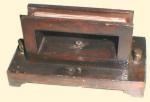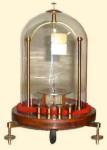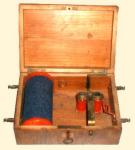
 Menu
Menu
|
Function To show the interaction between a current and a magnet. |

| ||
|
|||
|
Description A coil wound on a wooden frame is fixed on a wooden basis. At the ends of the basis we have two binding posts. Inside the coil we have a magnetic needle that can rotate horizontally. When the current flows the needle moves from its equilibrium position in the terrestrial magnetic field. The deviation is emphasized by the fact that the total current is the sum of the currents of the turns of the coil. | |||
|
Function To show the magnetic effect of the direct current. |

| ||
|
|||
|
Description The electromagnet is suspended to a brass column with an iron basis. It is made of a U iron rod on which is wound a hard-wire painted with sealing wax. By connecting the electromagnet to a cell, the electromagnet attracts a little metallic anchor given as equipment. | |||
|
Function To measure the current intensity. |

| ||
|
|||
|
Description The instrument stands on a wooden basis with three leveling screws. Four binding posts are placed on the edge. Two brass columns support the arc on which leans the screw that regulates the tension of the thread that holds the two needles. The ensemble is protected by a glass bell. The name “differential” derives from the fact that it is possible to measure the difference of intensity of two currents. | |||
|
Function To obtain high voltages. |

| ||
|
|||
|
Description The apparatus is formed by a circuit with an electromagnet and the primary circuit of a coil. Two thin layers that complete it with a simple contact are part of the circuit. The ensemble is placed in a wooden case. By closing the circuit a thin layer is attracted by the electromagnet interrupting the contact and opening the circuit. This provokes the demagnetisation of the electromagnet and for this the circuit closes and so on... In fact in the primary circuit we have a pulsating current that creates an induced current in the secondary circuit. The binding posts for the connection of the input voltage and the output voltage are placed on the external side of the case. | |||